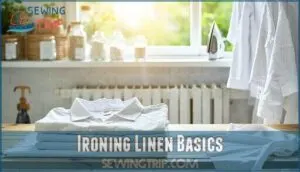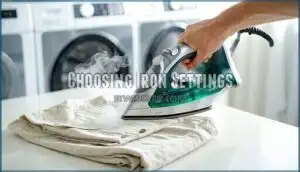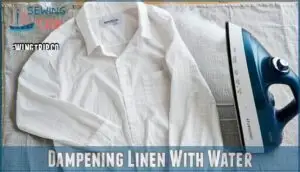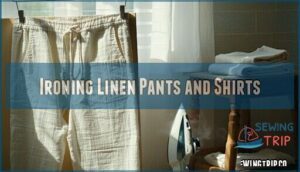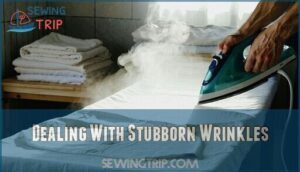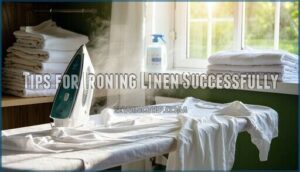This site is supported by our readers. We may earn a commission, at no cost to you, if you purchase through links.
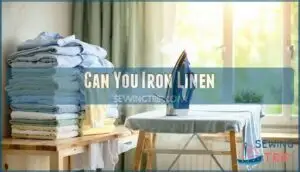
Linen is a durable, breathable fabric made from flax fibers, but it crumples easily.
To iron it safely, use a medium to high heat setting, preferably with steam, and iron it slightly damp—this helps smooth out creases faster.
Always press on the reverse side or use a pressing cloth to prevent shine or damage, and take your time to use steady, straight motions.
With the right technique, linen looks crisp and polished, and want flawless results, there are some tricks seasoned pros swear by!
Table Of Contents
- Key Takeaways
- Ironing Linen Basics
- Can You Iron Linen
- Choosing Iron Settings
- Preparing Linen for Ironing
- Ironing Linen Clothes
- Avoiding Damage and Shiny Spots
- Dealing With Stubborn Wrinkles
- Finishing Touches for Linen
- Alternatives to Ironing Linen
- Tips for Ironing Linen Successfully
- Frequently Asked Questions (FAQs)
- Conclusion
Key Takeaways
- You can iron linen safely using high heat and steam; keep it slightly damp for better wrinkle removal.
- Always use a pressing cloth or iron the reverse side to avoid shine or fabric damage.
- For stubborn wrinkles, focus on smooth motions and sectioned ironing.
- Steaming is a gentler alternative to maintain linen’s texture, and hanging it to dry can minimize wrinkles.
Ironing Linen Basics
Ironing linen is straightforward when you understand its unique qualities and how it responds to heat and moisture.
Master the art of ironing linen by learning its unique qualities—create crisp, wrinkle-free elegance with heat, moisture, and the right tools.
By using the right tools and techniques, you can easily restore its crisp, polished appearance.
Linen Fabric Characteristics
Linen fabric, crafted from the flax plant, excels in breathability and moisture-wicking, making it perfect for warm weather.
Its hypoallergenic nature suits sensitive skin, while natural crispness adds elegance.
Though linen wrinkles easily, this characteristic is part of its charm. Its lightweight feel and durability highlight excellent fabric care benefits, ensuring garments and furnishings stay cool and comfortable.
Benefits of Ironing Linen
Ironing benefits go beyond just wrinkle removal.
Ironing transforms linen, enhancing its crisp elegance while preserving its natural charm and long-lasting durability.
A polished finish enhances the appearance of linen fabric, giving it a crisp look perfect for clothing or home décor.
It also maintains fabric integrity, preventing damage from deep creases.
Iron linen regularly to keep linen wrinkles from setting in, preserving that elegant, natural charm while ensuring durability and long-lasting appeal.
High heat and steam remove stubborn wrinkles, which is essential for achieving a polished finish and maintaining fabric integrity.
Essential Tools for Ironing
To iron linen effectively, you’ll need a steam iron with adjustable heat, a sturdy ironing board for stability, and a pressing cloth to shield the fabric.
Keep a spray bottle handy to dampen the fabric, as this eases wrinkle removal. You can find a suitable steam iron online.
After ironing, use hangers for proper shape retention. These ironing tips guarantee a smooth, professional finish every time.
Can You Iron Linen
Yes, you can iron linen! In fact, it’s one of the best ways to keep this breathable, durable fabric looking polished and wrinkle-free.
While linen wrinkles easily due to its natural fibers, those creases are manageable with the right approach. A good Linen Ironing Guide can simplify the process.
Keep your steam iron handy, as moisture makes all the difference in taming those stubborn wrinkles. Whether you’re working with shirts, pants, or delicate linen fabric, consistent ironing techniques matter.
Always check the care label for specifics, and remember that linen blends often require slightly different handling. With these simple Ironing Linen Tips, maintaining crisp, elegant pieces becomes a skill you can master.
Plus, it’s satisfying to watch wrinkles disappear!
Choosing Iron Settings
When ironing linen, selecting the right settings is essential for avoiding damage. Use a high heat setting with steam, and always check the care label for specific guidance.
Temperature Settings for Linen
For linen fabric, ideal temperature matters.
Use the highest ironing temperature setting, between 350°F and 430°F, depending on fabric thickness.
Blended fabrics may need cooler settings.
Always check the care label to avoid heat damage.
Adjust iron type accordingly—many have linen-specific settings.
Proper temperature guarantees wrinkle removal without risking damage, key to effective linen care, ensuring effective linen care.
Steam Option for Linen
Using steam is a game-changer for linen care. It boosts wrinkle removal, protects delicate linen types, and enhances ironing techniques.
For quick touch-ups, consider steaming, as it’s convenient and fabric-safe.
To get the best results:
- Use the steam iron’s settings for consistent moisture.
- Hold it slightly above the fabric for effective steaming alternatives.
- Apply steam in gentle bursts to prevent damage.
- Steam effectiveness improves with high-quality tools.
Ironing Board and Pressing Cloth
A sturdy ironing board guarantees stability during linen ironing, keeping fabric smooth.
Pair it with a pressing cloth made of cotton or muslin for heat protection and shine prevention.
Remember, size matters—choose a board that fits your garments for easier handling.
Consider buying ironing accessories to improve your ironing experience.
These small adjustments refine your ironing techniques and protect linen fabric from damage or unwanted marks.
| Feature | Why It’s Important | Recommended Option |
|---|---|---|
| Board Stability | Prevents wobbling | Sturdy, wide boards |
| Cloth Material | Protects fabrics | Cotton/Muslin cloths |
| Heat Protection | Guards against scorching | Pressing cloth |
| Size Matters | Eases garment handling | Adequate board space |
Preparing Linen for Ironing
Preparing linen for ironing is essential to achieving a smooth, wrinkle-free finish.
Start by lightly dampening the fabric with clean water and always iron it on the wrong side to protect its texture.
Dampening Linen With Water
Before ironing linen fabric, dampening it with water helps relax the fibers and makes wrinkle removal easier.
Use clean water for the best results since water quality affects fabric appearance.
Aim for even dampness—too much moisture may delay drying, while too little can cause uneven ironing.
Proper moisture levels guarantee smooth linen ironing and effective ironing techniques, which lead to better results.
Using a Spray Bottle
A spray bottle makes dampening linen simple. Fill it with clean water—avoid hard water to prevent residue. Use a plastic bottle for durability.
Hold it about 12 inches away to guarantee even moisture without soaking. Mist lightly, focusing on dry areas, and avoid leaving water spots.
Linen is also suitable for professional dry cleaning. Balanced moisture helps relax linen fibers, improving your ironing techniques effortlessly.
- Clean, soft water protects fabric.
- Lightweight plastic bottles are easy to handle.
- Hold 12 inches away for uniform coverage.
- Mist lightly to dampen, not drench.
- Avoid over-spraying to prevent water spots.
Ironing on The Wrong Side
Turn linen inside out before ironing to prevent shiny spots, protect embroidery, and avoid damage to delicate fabrics. This technique guarantees fabric protection while keeping dark linens vibrant.
Use proper iron settings to reduce ironing mistakes and maintain quality. Here’s a quick guide:
| Task | Benefit | Tip |
|---|---|---|
| Iron inside out | Preventing shine | Use a pressing cloth too |
| Protect embroidery | Fabric protection | Iron gently over designs |
| Dark linens care | Avoiding damage | Use lower heat settings |
| Delicate fabrics care | Prevent shrinkage | Keep damp for easy pressing |
| Avoid mistakes | Lasting quality | Test heat on small areas |
The key to successful ironing is to iron gently and be mindful of the heat settings, especially for delicate fabrics. By following these tips, you can ensure your linens remain in good condition and look their best, which is essential for lasting quality and to prevent shrinkage.
Ironing Linen Clothes
Ironing linen clothes requires the right technique to guarantee a crisp, wrinkle-free finish without damaging the fabric.
With careful attention to temperature and fabric preparation, you can maintain linen’s natural texture and durability.
Ironing Linen Pants and Shirts
Start with linen pants first, laying them flat on the ironing board.
Focus on pressing creases along seams with smooth strokes, especially on pockets. For linen shirts, use deliberate shirt techniques—iron cuffs and collars last to perfect their shape.
Keep cuffs detailing crisp. A dampened linen fabric eases stubborn wrinkles, offering polished, professional results when you iron linen garments, using smooth strokes and focusing on deliberate techniques.
Ironing Linen Jackets and Coats
Tackling linen jackets and coats can seem tricky, but it’s easy with the right approach. Focus on lined vs. unlined pieces and delicate shoulder padding. Pay special attention to collar techniques and pocket ironing for a polished finish.
- Use medium-to-high heat for ironing linen suits.
- Always iron inside out to avoid shiny spots.
- Protect buttons by covering them with a pressing cloth.
- Flatten seams before moving to broader areas to ensure a smooth finish with special attention to details and achieve a polished finish.
Ironing Delicate Linen Fabrics
When ironing delicate linen fabrics, use a low heat or silk setting on your steam iron to prevent damage.
Always protect embroidery with a pressing cloth and handle linen garments carefully. For linen fabric blends, gradual heat adjustments work best.
Keep linen slightly damp and apply smooth pressing techniques. Steaming is a safe alternative for ironing delicate items effectively.
Irons with variable temperature settings are essential to prevent damage to fine materials.
Avoiding Damage and Shiny Spots
To keep your linen looking its best, it’s important to prevent shiny spots and damage during ironing.
Use a pressing cloth, avoid high heat, and maintain smooth, controlled motions to protect the fabric.
Using a Pressing Cloth
Using a pressing cloth is smart linen care.
It prevents shine, protects embroidery, and distributes heat evenly across linen fabric.
Place a clean, damp cotton cloth between the iron and your fabric.
This simple step avoids direct heat damage and works for all fabric types.
For alternatives, lightweight kitchen towels or pillowcases work perfectly.
Avoiding High Heat Settings
Linen fabric is prone to heat sensitivity, so using high heat can cause fiber damage and increase scorching risks.
Stick to safe temperatures on your iron’s settings, typically the linen or cotton mode.
Always test heat on a small area before ironing, and proper ironing of linen clothes requires caution—avoiding excessive heat preserves their natural texture and durability effectively.
Ironing in Smooth Motions
A smooth touch is key when pressing linen fabric. Use consistent pressure and overlap strokes to guarantee even results without creases.
Keep your steam iron steady and maintain fabric tension for best results. Follow these ironing best practices:
- Avoid rushing, adjusting your ironing speed for precision.
- Iron linen in sections for control.
- Stick to simple, steady motions for damage-free results.
To achieve the best outcome, remember that a smooth touch and maintaining fabric tension are crucial. By following these guidelines, you can ensure damage-free results and a professionally ironed finish.
Dealing With Stubborn Wrinkles
Stubborn wrinkles on linen can be tough, but they’re not impossible to handle if you use the right tools and techniques.
Combine steam, sectioned ironing, and a fabric steamer for effective wrinkle removal without damaging the fabric.
Using Steam to Remove Wrinkles
Steam works wonders on wrinkles.
A steam iron or fabric steamer relaxes linen fibers, making it easier to smooth out creases.
Keep the fabric damp, hold the steamer close but avoid direct contact.
Portable steamers are handy for rejuvenating linen clothes on the go.
Check the table below for quick tips:
| Tool | Purpose | Tip |
|---|---|---|
| Steam iron | Direct wrinkle removal | Keep linen damp while steaming |
| Fabric steamer | Gentle on delicate linens | Hold a few inches away for safety |
| Portable steamer | On-the-go revitalizing | Perfect for travel or quick touch-ups |
Ironing in Sections
When ironing linen in sections, focus on precision. Start with the collar first, guaranteeing a smooth finish.
Follow with seam prioritization, pressing flat along edges. Pay attention to pocket detailing for a crisp appearance.
Finish with cuff precision and the back panel for even results. Working in sections guarantees linen clothes look polished without damaging the delicate linen fabric.
Using a Fabric Steamer
A fabric steamer works wonders on linen fabric, especially for delicate fabrics or when traveling.
Choose from handheld or full-size steamer types, ensuring the steam function is strong.
Hold the steamer a few inches from the garment, moving it slowly for best results.
Steaming benefits include gentle wrinkle release without direct contact, unlike ironing.
Always check care labels first.
For ideal results, consider a steamer with faster heat-up times.
Finishing Touches for Linen
To keep your linen looking crisp and fresh, focus on the final steps like applying starch and checking for wrinkles.
Proper hanging and a quick inspection help maintain your linen’s quality and appearance over time, which can be considered a complete concept to follow for the best results.
Using Starch and Fabric Sizing
For a crisp look, starch benefits linen by adding structure, but it changes its texture.
Sizing application is a gentler option, maintaining breathability.
To apply:
- Test starch on a sample.
- Lightly spray starch or sizing onto damp linen fabric.
- Use proper ironing settings for seamless starch application.
Consider starch alternatives for delicate fabrics or casual wear, as they provide a useful option for varying needs, and maintain the overall texture.
Hanging Linen to Dry
To prevent wrinkles and maintain the quality of linen fabric, hang your linen clothes to dry in a well-ventilated drying environment.
Maximize airflow importance by spacing items apart; avoid direct sunlight exposure to protect colors.
Consider the fabric weight—heavier pieces need sturdy hangers for even drying.
This simple airdrying step keeps wrinkles minimal and fabrics looking fresh.
Final Inspection and Maintenance
After hanging linen to dry, give it a thorough look to check for missed wrinkles or stains.
Inspect seams and edges, smoothing any creases with your hands if needed.
For long-term care, fold garments carefully or use padded hangers for Post-Ironing Storage.
Address small tears with quick repair techniques, and consider professional cleaning for delicate linen fabric, which may require delicate handling.
Alternatives to Ironing Linen
If you’re not a fan of ironing, there are easier ways to keep your linen wrinkle-free.
Alternatives like air-drying or using a steamer can achieve a polished look without the hassle.
Air-Drying Linen
Let your linen dry naturally to reduce wrinkles and promote fabric softening.
Spread it flat on a hanger or lay it on a clean surface.
Use sunlight exposure carefully—too much can fade colors. Good airflow is key for quick drying time.
This ironing alternative is a gentle way to maintain your linen’s quality and overall care, using natural methods to preserve its condition.
Using a Steamer Instead of Iron
Using a fabric steamer is a great alternative to ironing linen, especially for delicate linens.
Steamer types, like handheld or full-sized models, offer flexibility and ease.
The steam function gently relaxes wrinkles without flattening the fabric’s texture.
It’s perfect for a quick refresh or travel steaming.
See a variety of linen steamer options online.
Compared to an iron, a garment steamer is faster and safer for linen.
Avoiding Ironing Altogether
Skipping ironing? No problem.
Linen can stay wrinkle-free with smart techniques like:
- Hanging Techniques: Hang garments immediately after washing to prevent deep creases.
- Wrinkle Sprays: Use a wrinkle release spray to relax the fabric fibers quickly.
- Rolling Clothes: Roll linen items instead of folding to minimize wrinkles during storage.
These simple ironing alternatives keep your linen fresh and ready.
Tips for Ironing Linen Successfully
In the context of ironing linen, mastering a few details can save you time and frustration.
Start with the right tools and techniques to make the process smooth and effective.
- Ironing frequency: Iron linen regularly to keep it crisp, but don’t overdo it—too much heat can wear out fibers.
- Water quality: Use filtered water in your steam iron to avoid mineral buildup that could stain your fabric.
- Storage solutions: Always store ironed linen folded or hung straight to prevent creases.
- Linen blends: For blends, adjust the temperature to the most delicate fiber to avoid damage.
- Iron maintenance: Keep your iron clean and use its steam function to smooth stubborn creases effectively.
These simple ironing tips for linen guarantee your clothes look their best while minimizing linen shrinkage or wear.
Frequently Asked Questions (FAQs)
Can You iron linen?
Yes, you can iron linen.
Use high heat, dampen it slightly, and apply steady strokes. A steam iron works well.
Protect delicate areas with a pressing cloth and always follow care label instructions.
How to set the iron for cotton and linen fabrics?
Set your iron to the cotton/linen setting or use medium to high heat, around 230°C (445°F).
Add steam to tackle wrinkles.
Keep the fabric slightly damp, and use smooth, steady motions.
How do I choose a good linen iron?
A stitch in time saves nine—choose a steam iron with adjustable heat settings, a sturdy soleplate, and strong steam output.
Look for a spray function and a pressing cloth to protect delicate linen fibers.
How do you iron linen?
Iron linen while it’s damp, using a high heat setting and steam.
Work in sections, gently smoothing wrinkles with steady strokes.
Use a pressing cloth for protection, and always check care labels beforehand.
Can 100% linen be ironed?
Absolutely, you can iron 100% linen.
Always keep it slightly damp for smoother strokes and set your iron to high heat.
Use steam or a pressing cloth to protect fibers and prevent shine.
How do you get wrinkles out of linen?
To remove wrinkles from linen, dampen it slightly with a spray bottle, then use a hot iron with steam.
Press firmly but gently, moving in straight strokes.
For a gentler option, try steaming instead.
Is it better to steam or iron linen?
Did you know linen is 30% stronger when wet?
Steaming is gentler, ideal for delicate embroidery, but ironing gives sharper creases.
Use steam for quick fixes and an iron when precision matters most.
Is it okay to wear wrinkled linen?
It’s perfectly okay to wear wrinkled linen—it’s part of the fabric’s charm.
Those natural creases give it character, signaling effortlessness and style.
Just embrace the look, and you’ll appear relaxed and elegant.
What is the best temperature to set the iron when ironing linen?
Picture the steam rising like morning mist—set your iron to 200°C-230°C (cotton/linen setting).
Keep linen slightly damp, use smooth strokes, and let steam do the work.
It’s heat, not haste, that’s key.
How often should linen clothes be ironed?
Iron linen clothes as needed based on their appearance, not a strict schedule.
They wrinkle easily, so touch them up whenever they look creased.
Keep them slightly damp during ironing for smoother results.
Conclusion
If you’re wondering, “Can you iron linen without damaging it?” the answer is yes—if you follow the right techniques.
Use medium to high heat with steam, iron while it’s slightly damp, and always press the reverse side or use a pressing cloth.
Smooth, steady motions will eliminate wrinkles while avoiding shine and damage.
With proper care and some patience, your linen will look crisp and polished, and ironing becomes a hassle-free way to maintain its timeless appeal.
- https://en.wikipedia.org/wiki/Ironing
- https://www.roughlinen.com/blogs/newsletters/can-you-iron-linen?srsltid=AfmBOop06jFmC9uVlUJ3fUVJpyalZSnukhxFQKkZIdQOAUVtrHgH84Uk
- https://luxmii.com/blogs/news/essential-questions-can-you-iron-linen-clothing
- https://nori.co/a/blog/best-irons-for-delicate-fabrics?srsltid=AfmBOoqhcCv6i7J40lTh1OxyRfczBjAMTUvyv5FBxkhp18STUuNtBHt6
- https://www.quora.com/Is-it-safe-to-use-a-regular-iron-on-linen-fabric

